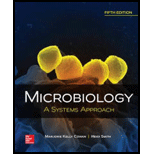
Concept explainers
a.
To determine:
The location of the membrane attack complex in gram-negative and gram-positive bacteria.
Introduction:
A group of proteins can work in several pathways to kill the invading pathogen. The end product of the “complement system” is a membrane attack complex. This defense system is called a nonspecific defense because there is no specificity between the pathogen and the serum proteins of the complement system.
b.
To determine:
Gram-positive and gram-negative bacteria, which are more resistance to the formation of membrane attack complex.
Introduction:
The complement system is a very important part of the immune system that enhances the ability of antibodies and phagocytic cells to inhibit the growth of microbes and damaged cells from an organism and attacks the pathogen's cell membrane.
Want to see the full answer?
Check out a sample textbook solution
Chapter 14 Solutions
Microbiology: A Systems Approach
- PLEASE ANS ASAP 1. When placed into a hypertonic solution, a bacterial cell will: a:die as a result of dessication. b: lyse c: swell d. take in more water than it releases . 2. Which one of the following methods of antimicrobial susceptibility testing requires a dilution series of the antibiotic and can provide a minimum inhibitory concentration? a. Gradient diffusion method b. Agar macrodilution method c. Broth microdilution method d. Disk diffusion method 3. Blood for culture is usually obtained from a vein located in which area? a. Brachial b. Femoral c. Axillary d. Antecubital 4. All clinical specimens submitted to the clinical microbiology laboratory must be: a. all of these b. property and carefully collected. c. properly labeled. d. properly transported to the laboratory 5. Contact precautions are required for patients with a. all of these b. respiratory syncytial virus c. Clostridium difficile c. associated diseases. d. infections caused by multidrug-resistant…arrow_forwardQuorum sensing. It sounds cool! But what is it? Explain in your own words what is quorum sensing and how it and biofilms are beneficial to a bacterial community. Also, include how they impact human health.arrow_forwardPlease answer both questions asap. Thank you. - Why would SV40 cause the culturing to occur of HMLE cells (mention SV40 targets regarding their function)? - Why would hTERT culture HMLE cells?arrow_forward
- Thank you very much for your help How do the differences between gram-positive and gram-negative cell walls influence the cell’s clinical behaviour, detection and treatment?arrow_forwardThink about minimal inhibitory concentration (MIC) assays. A set of tubes, all containing the same amount of bacterial cells, have decreasing amount of antibiotic X added to them. Tube 1 had 0mg/ml, Tube 2 has 100mg/ml, tube 3 has 50mg/ml, 4=25, 5=12.5, 6=6.25, and tube 7 has 3.125. If bacteria grew in tubes 1, 4, 5, 6, 7, what is the MIC of this antibiotic for this bacteria? Select one: a.None of the Above b.3.125 mg/ml c.25 mg/ml d.0 mg/ml e.50 mg/mlarrow_forwardAll questions a) Name structures P, Q and R. b) Name substance S . c) What is the enzyme encoded by gene I. Give its function. d) What will happen if substance S is absent in the medium?arrow_forward
- Most of the volume of T. namibiensis cells (The bacterium Thiomargarita namibiensis—at about 0.1 to 0.3 mm in diameter—is visible to the human eye.) is occupied by a large central vacuole. Why were scientists surprised to discover a bacterial cell containing a vacuole?arrow_forwardANSWER BOTH ITEMS WITH EXPLANATION1. what becterial cell structure serves as the site of antibacterial action?a. cell membraneb. nuclear membranec. cytoplasmd. cell wall2. During the bacterial locomotion, the direction depends on the rotation of the flagellum. when a bacterial cell tumbles, the rotation of the flagellum isa. ccb. ccwc. bothd. neitherarrow_forwardWhat similarities and what differences between the graphs? What antibiotics were the most successful at killing the cave bacteria? Which antibiotics were the least successful? What evidence supports this claim? How many of the 26 antibiotics successfully killed 100% of the bacterial strains? What does this say about our ability to fight infections with our current arsenal of antibiotics? Which target of bacteria seems to be the most resistant to antibiotics? Why might that be? Did any antibiotics affect gram-positive and gram-negative strains very differently? From what other environments might scientists collect bacterial samples to further test their hypothesis that antibiotic resistance is a trait that evolved without being influenced by modern antibiotic use?arrow_forward
- Vaccine development for diseases caused by protists (e.g., malaria, Chagas’ disease) has been much less successful than for bacterial or viral diseases. Discuss one biological reason and one geopolitical reason for this factarrow_forwardBAX vs VIDAS: Two automated methods for detection of pathogenic microbes How are these methods similar? Are there advantages to one vs the other? Describe the technology behind each system.arrow_forwardTripling lime The number of bacteria in a colony increases at a rate propoJtional to the number present. If the number of bacteria doubles in 10 hours, how long will it take for the colony to triple in size?arrow_forward
 Biology (MindTap Course List)BiologyISBN:9781337392938Author:Eldra Solomon, Charles Martin, Diana W. Martin, Linda R. BergPublisher:Cengage Learning
Biology (MindTap Course List)BiologyISBN:9781337392938Author:Eldra Solomon, Charles Martin, Diana W. Martin, Linda R. BergPublisher:Cengage Learning
